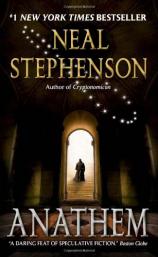Anathem
Review
Anathem
ANATHEM, Neal Stephenson’s new novel, centers on a young
man named Fraa Erasmas, a monk, of sorts, residing within the walls
of the Concent of Saunt Edhar. There, he and his fellow
residents/students devote their lives to the understanding of math,
science, cosmology, metaphysics and more. Everything must have
reason and be provable, or it is invalid. In such a place, the
residents are segregated, to a degree, and in some instances none
can know what the others know.
Fraa Orolo, Erasmas’s mentor, finds himself "Thrown Back,"
or cast out of the concent for a violation. Erasmas, Lio, Ala,
Jesry and a handful of others begin a secret quest to discover what
it was Orolo was working on that got him Thrown Back. When they
discover that he has located what appeared to be an alien ship
orbiting the planet, it is not too long before they, and others,
are called upon and shipped out of the concent as well, destined to
meet at another location for a special gathering.
Erasmas, however, is intent on finding Orolo. Splitting off from
the main contingent, he begins a quest to locate Orolo and bring
him back to the meeting. There, the gathering of the avout will
determine the proper course for dealing with this alien
arrival...if they don't destroy each other first. Or if the aliens
don't launch their attack before a decision can be made.
Yes, ANATHEM is science fiction. The events take place on a
planet known as Arbre. Even so, it bears many striking similarities
to Earth. While it can be somewhat disconcerting, a number of
things are given new names, but descriptions eventually lead you to
understand what they are. Of course the presence of an alien
spaceship qualifies it as a science fiction tale, yet, at its core,
the book is more about thought than, well, enjoyment.
At any given moment, Stephenson sits back and spends an
inordinate amount of time regaling you with his brilliance. And
let's be honest, he is brilliant. Even so, paragraph upon
paragraph of intellectual infighting amongst scholars, page upon
page of metatheoric argument and scientific regurgitation make the
reading of ANATHEM a true slog. The book begins slowly, introducing
you to Saunt Edhar and its setup, and the introduction of Erasmas
and a few of his companions. And the clock. And how the clock
works. And why the clock works that way. And who designed the
clock. And who decided it would work the way it works. And what
scientific formulae were used in such a decision. This depth of
explanation, while creating a fully immense world, can weigh far
too heavily on the mind of the person trying to read it.
Within ANATHEM, there is a book called, ironically enough, The
Book. It is a tome of punishment. The punished are forced to read
and copy and understand the chapters they have been assigned and
will then be quizzed on those chapters. Each chapter of The Book is
increasingly more difficult, and at one point they become so
preposterously difficult that the reader is ultimately driven to
insanity. Reading ANATHEM can have a similar effect.
Not wholly unworthy, ANATHEM will assuredly find a following.
But on the whole, it pales in comparison to Stephenson's previous
gems, such as SNOW CRASH, CRYPTONOMICON and The Baroque
Cycle.
Reviewed by Stephen Hubbard on December 22, 2010
Anathem
- Publication Date: September 1, 2009
- Genres: Fiction, Science Fiction
- Mass Market Paperback: 1008 pages
- Publisher: Harper
- ISBN-10: 006147410X
- ISBN-13: 9780061474101





